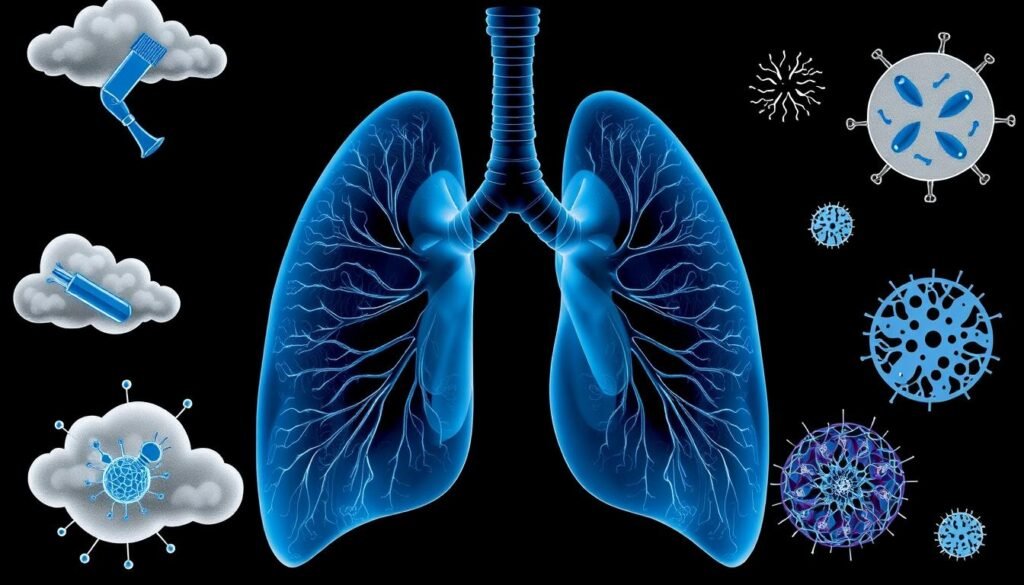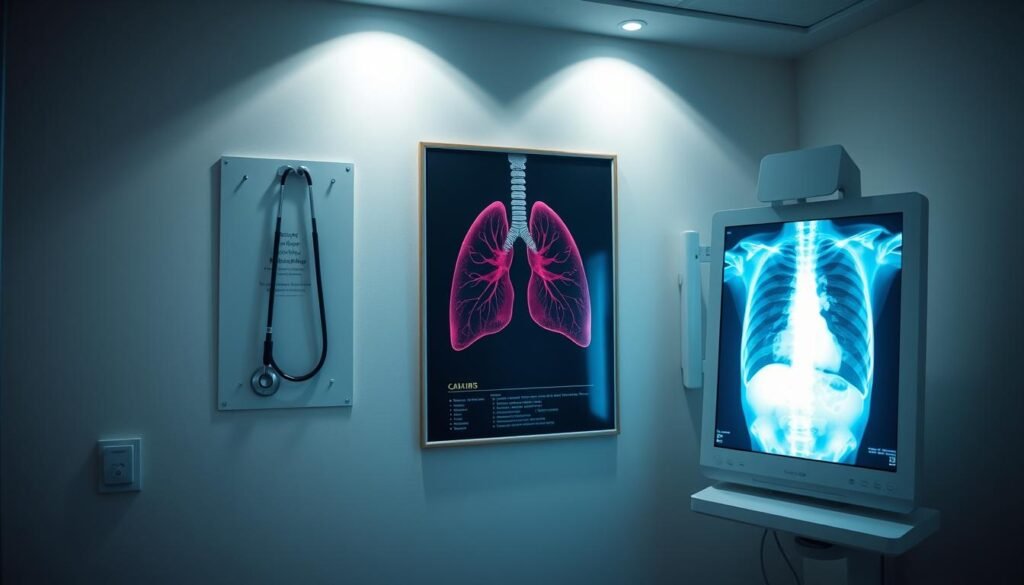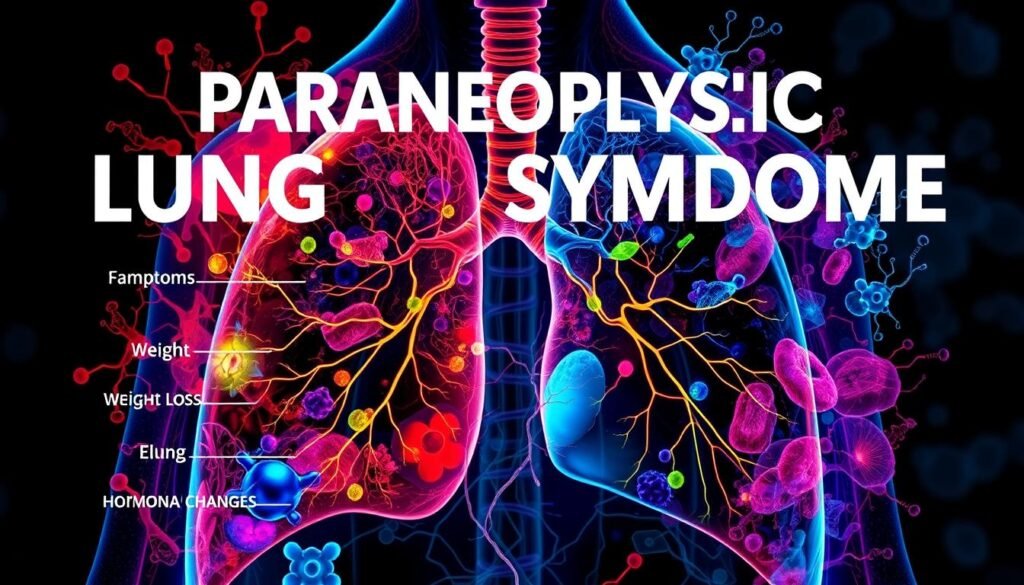About 68% of people with lung cancer lose weight without trying by the time they are diagnosed. This fact highlights the need to know the early signs of lung cancer. Often, these early symptoms can seem small or not dangerous but are key for figuring out a person’s health early on. Knowing what to look for is crucial because acting fast can mean earlier diagnosis and better treatment options.
There are many symptoms of lung cancer, but knowing the early signs can save lives. Paying attention to things like lasting coughs, losing weight without trying, and chest pain means people might get the medical help they need sooner. Sometimes, these early lung cancer signs can look like other health issues. This shows why it’s important to get check-ups and screenings from doctors.
Key Takeaways
- Approximately 68% of lung cancer patients experience unexplained weight loss at diagnosis.
- Recognizing early signs like persistent cough and chest pain is crucial for early detection.
- Common early signs of lung cancer can be mistaken for less severe ailments.
- Prompt medical evaluation can lead to better treatment outcomes.
- Annual screenings are recommended for high-risk individuals.
Understanding Lung Cancer
Lung cancer is a major health issue worldwide. It’s the top reason for cancer-related deaths. This lung cancer overview highlights key points about the disease, its types, and risks. Mainly, there are two types: non-small cell lung cancer (NSCLC) and small cell lung cancer (SCLC). NSCLC accounts for about 85% of all cases. SCLC, on the other hand, is rarer but more aggressive.
Knowing lung cancer facts is crucial for early detection and treatment. Many don’t show symptoms until it’s advanced. But some early signs lead to early screening and awareness. This is important for catching it sooner.
- Risk factors include smoking and secondhand smoke.
- Environmental toxins like radon, asbestos, and other harmful substances also play a role.
- A family history of lung cancer can make you more likely to get it, showing why knowing your health history matters.
Catching lung cancer early can make treatment more successful. Understanding the different types can help. Regular doctor visits are key in lowering deaths from lung cancer. For more info on lung cancer, check out this detailed guide.
Common Early Signs of Lung Cancer
It’s important to recognize early signs of lung cancer for better treatment results. Sometimes, these signs are overlooked because they seem minor. Knowing what signs to look for helps catch the disease early.
Persistent Cough
A persistent cough is often an early lung cancer sign. If a cough doesn’t go away or gets worse, it’s a red flag. This cough might feel annoying and might seem like a cold or allergies. Watching how the cough changes is key for early detection.
Coughing Up Blood
Coughing up blood is a serious symptom that shouldn’t be ignored. It could signal a problem in the lungs that needs quick attention. Getting checked out as soon as this happens is crucial for effective treatment.
Chest Pain
Chest pain is often reported with lung cancer’s early signs. This pain gets worse with coughing or deep breaths. It’s easy to confuse with other issues, but it might be lung cancer. If you feel this pain, get checked out right away. You can find more info about treatments at the Cleveland Clinic.
Identifying Symptoms in Men
Lung cancer symptoms in men can differ from those in women. This often leads to a later diagnosis. Men might notice symptoms like a persistent cough, unexplained weight loss, and severe chest pain. These are early signs of lung cancer.
Men’s symptoms are influenced by higher smoking rates. Smoking increases the risk of squamous cell lung cancer. This type is more common in male smokers.
It’s vital to understand how lung cancer symptoms vary by gender. This knowledge can aid in early detection. Although both genders may share symptoms like shortness of breath and chronic coughing, men have a higher risk of aggressive cancers. For example, small cell lung cancer can cause facial swelling and bloody mucus.
Knowing the gender differences in lung cancer symptoms helps create better public health strategies. It’s crucial to recognize lung cancer signs early in men. Since early symptoms can be subtle, raising awareness is key for improving outcomes.
| Symptom | Men | Women |
|---|---|---|
| Persistent Cough | Common | Common |
| Chest Pain | More Severe | Moderate |
| Weight Loss | Frequent | Frequent |
| Shortness of Breath | Common | Common |
| Bloody Mucus | Possible in Late Stages | Possible in Late Stages |
Fatigue and Weakness as Warning Signals
Fatigue often starts early in lung cancer and is important to notice. It shows as tiredness that doesn’t go away, even when the body fights hard against cancer. This leads to a big drop in energy.
When energy drops, people might also lose weight and not feel like eating much. If you think it’s just normal tiredness and don’t check it out, you could miss getting help early. Knowing these signs can lead to faster help and treatment.
Unexplained Tiredness
Lung cancer warning signs often include feeling very tired without a clear reason. Some might think it’s just because they are busy or stressed. But, it’s important to see if this tiredness is actually pointing to lung cancer.
The cancer can use up a lot of what your body needs, making you feel worn out. This type of tiredness is different because it doesn’t go away with rest.
- Potential signs accompanying fatigue:
- Unplanned weight loss
- Decreased appetite
- Shortness of breath
Fatigue could mean many health problems, but it’s key to look deeper if it comes with weakness. Knowing about fatigue’s role in lung cancer helps people make smarter health choices.
| Symptom | Possible Indicator of Lung Cancer |
|---|---|
| Unexplained Fatigue | Yes |
| Persistent Weakness | Yes |
| Weight Loss | Yes |
| Loss of Appetite | Yes |
| Frequent Shortness of Breath | Yes |
Shortness of Breath and Wheezing
Shortness of breath, or dyspnea, is a warning sign that might point to lung cancer. As tumors grow, they can block or squeeze the airways. This often leads to difficulty breathing, which can impact daily life.
Wheezing is another sign to watch out for. It sounds like a whistle when breathing. Both wheezing and shortness of breath are key symptoms of lung cancer. They suggest something may be blocking the airways or that oxygen levels are low.
Finding ways to ease shortness of breath is crucial. One way is through noninvasive procedures, like bronchoscopy. Also, adopting healthy habits can help manage symptoms. Some good practices include:
- Quitting smoking and avoiding secondhand smoke
- Staying well-hydrated
- Engaging in deep breathing exercises
- Ensuring adequate rest
- Maintaining a balanced diet
It’s important to notice early warning signs like shortness of breath and wheezing. They urge a quick visit to the doctor for tests. Early detection is key to fighting lung cancer, a disease with a high death rate.
Recurrent Respiratory Infections
Frequent infections in your lungs are a big health worry. They are especially concerning as signs of lung cancer. People might often get bronchitis and pneumonia. These issues can hide deeper health problems.
These infections come with various symptoms. It’s important to not ignore them.
Bronchitis and Pneumonia Symptoms
Common signs of bronchitis and pneumonia include:
- Persistent cough: A cough that lasts more than eight weeks is a key alert.
- Difficulties breathing: If you’re short of breath after just a little activity, take note.
- Chest discomfort: Pain in the chest for over a month, getting worse when you breathe or cough, needs quick checking.
- Mucus production: Making mucus for a month or more could mean serious lung issues.
- Wheezing: This sign points to blocked airways and possibly early lung problems.
- Coughing up blood: Also called hemoptysis, it can hint at serious lung or upper respiratory tract diseases.
Watching for these signs is very important, especially if lung cancer is a risk. Tumors in the lungs can mess with how you breathe. This leads to more pneumonia or bronchitis. Catching these signs early helps with treatment success.

Importance of Weight Loss
Unexplained weight loss and losing appetite are big warning signs of health issues like lung cancer. Many people with lung cancer notice they don’t feel as hungry. They also see their weight go up and down a lot. Spotting these signs early can help catch lung cancer soon. This leads to better chances of treating it.
Unexplained Loss of Appetite
Weight loss that can’t be explained is often a sign of lung cancer. About 60 percent of people with lung cancer lose weight without trying. Some even lose weight before doctors figure out they have cancer. This happens to around 40 percent of folks with lung cancer.
Weight usually starts to drop only after the cancer has gotten worse. Lung cancer can change how the body handles food. It makes people feel less hungry. It also stops the body from getting all the nutrients from food. Treatments like chemotherapy or radiation can make this worse. They can make you feel sick or very tired.
Cancer cachexia is another problem in late-stage lung cancer. It’s when the body can’t use nutrients well anymore. This leads to a cycle of losing weight, feeling stressed, and being tired. All these make recovering harder. It’s very important for people with these signs to get help quickly. Doctors might suggest special meal plans or supplements to stop the weight loss.
| Statistical Insight | Percentage |
|---|---|
| People diagnosed with lung cancer reporting weight loss | 60% |
| Initial cancer diagnoses that present with weight loss | 40% |
| Advanced stage lung cancer with associated cachexia | Varies |
Keeping a cancer diary can be really helpful. It lets you track changes in weight and eating habits. This gives doctors a lot to work with. They can make care better by customizing your treatment. Knowing and watching out for these signs can make a big difference. It means getting help sooner rather than later.
Seeking Medical Attention
People who notice early lung cancer signs need to seek medical help. Signs like a persistent cough, losing 10 pounds without trying, or other unusual symptoms mean a doctor’s visit is needed. Spotting cancer early can greatly improve treatment effectiveness.
Knowing when to see a doctor is key. Symptoms like chest pain, a hoarse voice, or infections might seem minor but could be serious. Recognizing these signs early can lead to the right help quickly.
Doctors might suggest tests like chest X-rays or CT scans for lung problems. Following advice like the American Cancer Society’s yearly LDCT scans for those at risk helps find cancer early.

It’s vital to take charge of your health. Don’t ignore symptoms that could hint at lung cancer. Catching it early can change how well treatment works.
To learn more about lung cancer signs and when to get help, visit this informative resource.
Understanding Pancoast Tumors
Pancoast tumors are a rare type of lung cancer found at the top part of the lungs. They make up about 3% to 5% of all lung cancers. This makes them quite rare but very important to those studying lung cancer.
Patients with Pancoast tumors often feel a lot of pain in their shoulder. This pain is reported by 44% to 96% of these patients. It’s the most common early sign of this cancer. Also, around 40% might get *Horner’s syndrome*, which causes droopy eyelids and small pupils. Knowing these signs is key to finding and treating the cancer quickly.
Most people who get Pancoast tumors are in their sixties. More men get it than women. Half of these tumors are adenocarcinoma, the rest are mostly squamous cell carcinoma. Doctors often need to take out the top part of the lung and some nearby tissues during surgery.
Treatment usually starts with chemotherapy and radiation before surgery. This is done to make the tumor smaller. This helps surgery to go better. About 75% of patients are able to have surgery after these treatments.
Even with new medical techniques, treating Pancoast tumors is hard. They grow close to other body parts, which can make surgery difficult. For anyone with symptoms of Pancoast tumors, getting help fast is crucial. It can make diagnosing and treating the cancer easier, helping with recovery.
Paraneoplastic Syndromes in Lung Cancer
Paraneoplastic syndromes are special symptoms of lung cancer. They don’t come from the cancer itself but from how the cancer affects the body. These symptoms can change how well a patient does after they find out they have cancer. About 10% of people with lung cancer have these symptoms. In people with small cell lung cancer, the number is even higher.
Almost half of the people with lung cancer may notice these symptoms before they know they have cancer. This shows how important these symptoms are for finding the cancer early.
Common syndromes include:
- Hypercalcemia: About 8-12% of people have it. It’s mostly seen in squamous cell carcinoma. It’s a big part of how lung cancer affects the body.
- Syndrome of Inappropriate Antidiuretic Hormone Secretion (SIADH): This affects 10-45% of people with small cell lung cancer. It shows how lung cancer can mess up hormone levels.
- Ectopic Cushing’s Syndrome: Found in up to 50% of lung cancer cases. This syndrome shows the big hormone changes that cancer can cause.
- Limbic Encephalitis: This is mostly found in people with small cell lung cancer. It shows how lung cancer and brain symptoms are connected.
Knowing about these syndromes helps doctors find lung cancer faster. This is especially true when the usual symptoms of lung cancer aren’t there. Understanding how these symptoms and lung cancer are linked can help people get treatment sooner. This can make their lives better and longer.

| Paraneoplastic Syndrome | Prevalence | Associated Symptoms |
|---|---|---|
| Hypercalcemia | 8-12% | Fatigue, nausea, confusion |
| SIADH | 10-45% | Hyponatremia, fatigue |
| Ectopic Cushing’s Syndrome | Up to 50% | Weight gain, high blood pressure |
| Limbic Encephalitis | Not precisely defined | Cognitive changes, seizures |
| Venous Thromboembolism | 3% | Pain, swelling in limbs |
Signs of Advanced Lung Cancer
As lung cancer gets worse, it shows symptoms that can greatly impact a person’s life. It’s important to spot these signs early on to help manage them better. Cancer spreading to other parts of the body is common in the later stages. This spread, known as metastasis, leads to various symptoms and discomfort.
Bone Pain and Neurological Changes
Bone pain is a common symptom, especially in the back or hips. This pain can mean the cancer has spread to the bones. This is often seen in more advanced cancer stages. People might also feel dizzy, numb, or weak. These feelings can happen when the cancer affects the brain or nerves.
Spotting these symptoms early is key to managing them. Knowing about symptoms like bone pain and changes in how you feel or move is important. It helps those with lung cancer and their carers understand and deal with the condition better.
If you have these symptoms, especially with a history of risk factors, see a doctor. Getting help early can improve care and outcomes. For early signs of lung cancer, check out here.
Conclusion
It’s critical to know the early signs of lung cancer to boost awareness and health actions. Symptoms like ongoing cough, unexplained weight loss, and constant tiredness are key for early finding. Catching these signs early can help treat the disease more effectively.
This is especially important as lung cancer is a top cause of cancer deaths in the U.S. Knowing the signs can save lives. High-risk groups, like smokers, should get checked often. For tips on spotting these early signs, check out this useful link. Spreading knowledge and encouraging people to get checked can lead to early treatment.
Spotting lung cancer early can greatly increase the chance of surviving. For example, the survival rate for Non-Small Cell Lung Cancer can be as high as 65% if caught early. The numbers show that being alert to lung cancer risks is a life-saver. It can make our communities healthier.